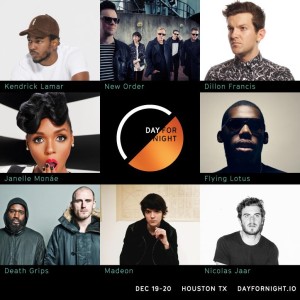#DayForNight, See It, Do It, Be It

By Leslie Raymond
Featured image: Still from Battles’ video for Dot Net
Transformation of reality — transporting audiences from one reality to another — is a specialty of the artist.
Through the regenerative properties of creative energy, we have the power to reshape our world. Take Day For Night performing artists Death Grips, a band that says it converts raw negativity into their music. The world provides no shortage of “raw negativity” for Death Grips to reshape, and the result is not what anybody would call delicate or dainty — this is not your grandma’s harpsichord overture — but it sure beats the raw headlines in the news these days. DFN artist Prince Rama perform a similar conversion by co-opting Monster Energy drink for their own alchemical purpose of “tapping into our inner demons and releasing them through a transformative sonic process.” Likewise, visual artist Zach Leiberman builds tools that offer spaces of creative play and discovery, and embody the potential for social evolution. Audiences who play with Liberman’s art can let their own creative juices flow in a space where they can often interact others and even form new friendships.
Transforming day to night is a traditional challenge of the filmmaking arts. “Day for night” is a cinematic technique by which a scene that appears as nighttime on screen was actually shot during the day. In-camera and post production processes, both low and high tech, are used to bypass the complications presented by nighttime shooting.
A conjuring trick laid on top of the magic of cinema moves the clock ahead half a day.
Scale/Immersion
Movies are magic because they trick our mind into believing we are embedded inside of that cinematic space. We exist inside of the unfolding picture story, and our relationship with actual physical space is temporarily suspended.
Just as we learn verbal language — vocabulary, syntax, tenses and conjugations — so, likewise, we absorb the special language of the movies. If we travelled back in time 200 years to show our ancestors a modern day movie, they would be confused. We, on the other hand, understand that an establishing shot shows us the setting where the scene is taking place. We grasp the grammar of a reverse shot without getting lost in space and time. We know, without deconstructing the event, that we feel closer to a character in close-up.
Movies at the movie theater engulf us, in part, because of the “real-time” representation of reality unfolding before us, but also because of their sheer scale. The the beholder and the size of the thing beheld are always interrelated. Churches and government buildings are giant for a reason.
Our present-day gods — movie stars — were born with the invention of the close-up.
With our every-day lives being increasingly occupied by screens of all sizes — from urban scale to smartphones — DFN artist Refik Anadol questions how our experience of space may be changing. The precursor to Anadol’s Infinity Room is avant garde artist Yayoi Kusama’s series of infinity mirror room installations, starting in 1965 and continuing today. The work immerses the viewer in an alternate reality, inspired by the artist’s hallucinatory visions. The distinction between viewer and environment is blurred. Where does the viewer end, and where does the external world begin? If the screen is a portal to another reality, then “reality” must be leaking — in and out — all over the place.
There are several large-scale and multi-screen moving image installations included in Day For Night, which may carry us to other worlds by way of both scale and their circumstance of unfolding in time. This includes Joanie Lemercier’s multiscreen installation Blueprint, Alex Czetwertynski’s installation with projection Photoperiod, Markus Heckmann’s a/v installation Transduktor, and Zach Leiberman’s architectural scale projection re:flect.

An audiovisual piece by Joanie Lemercier and James Ginzburg. Visuals: Joanie Lemercier ,Music: James Ginzburg and Yair Glotman, Production: Juliette Bibasse. The original creation of Blueprint was commissioned by STRP biennale 2024. Photo by Tanti Sofyan.
Interactivity
Interactive installations may be responsive environments in which our presence alters what is happening in the space. Where does the art happen? Is it in the artist’s studio? Is it the work of art itself? I propose that it is in the encounter between the viewer and the artwork. The artwork extends itself into the viewer and the viewer extends herself into the artwork.
The active and dynamic interface between the two becomes more pronounced in interactive installations where the presence of the viewer activates the artwork. The artwork exists as a closed system on infinite loop, and becomes alive when the viewer inserts herself. If a tree falls in the forest and nobody is there to hear it, does it make a sound?
Primary Forms by Mark Eats is a large scale interactive graphic study of the natural world. Gabriel Pulecio presents us with Light Collider, a kinetic interactive installation experience. Work-Order invites us to Come Touch It, their giant bug-zapper, and Masomenos’ work, The Audio Reflex Frames, responds to its immediate sound environment.

Detail of Collider by Gabriel Pulecio. Image courtesy of the artist.
Participation
A distinction can be noted regarding “interact,” which suggests having an effect upon, and “participate,” meaning to take part in. More give and take is implied by participation.
Lila Wallace of the Wallace Foundation believed in art for all, and her family foundation’s recent series of in-depth studies about building arts audiences demonstrate that participation is key. Who is surprised that our impulse and interest is to be engaged and to participate?
The concept of participatory experience is rising through many fields. For example, “Museum 2.0” defines a need for cultural institutions to genuinely connect with the public and make art relevant to more people. An audience-centered focus converts the passive observer to an active participant, resulting in a richer and more rewarding experience for host and visitor alike.
The last decade has also seen a revival of participatory art, also known as relational aesthetics, also known as social sculpture, with roots in Fluxus and Happenings of the 1960’s. Way before that, there was tribal art and folk art. When counterculture was king in the 1960’s, people sought alternative ways of being, thinking, worshiping, and relating to one another. The Fluxus artists sought to break down the boundaries between art and life. Yoko Ono, seminal to that movement, created conceptual art poems, event scores, instruction works, and happenings such as Cut, where she gave the audience permission to cut off pieces of her clothing, becoming vulnerable to the impulse of the collective. Long before Burning Man, Happenings were characterized by active audience participation, elimination of the boundary between the artwork and the audience, and oftentimes the expectation was full participation by all present at the art event.
DFN musician Dan Deacon has created an app to facilitate audience participation. It turns everyone’s cameras into a color flash generators, allowing the entire audience to become embedded in the fabric of his performance through participation in an interactive light show. The app simultaneously jams anyone’s attempt to take pictures. Subtracting the recording screen from the situation helps bring people into the present by removing their ability to to document. Be here now, and don’t annoy others with your screen.
Deacon challenges us all to take responsibility for our existence. “Progressives think they vote by not voting; voting a vote of no confidence is different than not voting at all.” Everyone can exercise their creative energy. This is how reality comes about and it is DIY. Punk. It is an act of rebellion to take back our creative energy from the sphere of consumer culture. And it can become art.
Dan Deacon’s concert finds a counterpart with David Cihelna & Gene Han’s Sparse, a music performance in which the crowd is sourced as a collective speaker. Reminiscent of the public space reclamation practiced by Reclaim the Streets, wherein a low-power FM transmitter broadcasts a signal within a short radius to participants’ boomboxes to circumvent laws against gatherings with amplified music, Sparse takes this a step further by splitting a musical piece into a variety of parts and then distributing those parts across participants’ handheld devices. The result is “a continuously morphing musical performance that responds to the size of the crowd,” which uses the very devices that would alienate us from one another by removing us from the present and projecting us into our various cyberspaces to instead connect us in a living web.

Still from promotional video for Sparse by David Cihelna & Gene Han., Courtesy of the artists.
Man v. Machine
Social media, a technologically enabled mode of communication, has given humans the ability to participate in writing the meta-story of our daily existence. Not too long ago, there were just three main TV stations (plus public television) pushing out news and entertainment to “the masses” — just a few producers broadcasting to many consumers. With the advent of social media, however, what was once one-to-many has now become many-to-many. I craft the story (artfully or not) and transmit via the abundance of communication outlets. Peer to peer is participatory.
The explosion of electronic chitchat is driven by our inherent social wiring as human beings. Both Anonymous and ISIS are possible today because of the online communications technology. Social media keeps us informed about global affairs in the same context that we stay in the loop with friends and family members — we see photos from the big news events of the day alongside snaps of our friends’ babies, pets, and lunch.
As usual, artists co-opt contemporary communications media and discover new ways of conveying the story. Night Moves has produced a series of minimal motion graphic loops intended for two distinct contexts: hand-held devices via Instagram and the gallery.
We reportedly spend an average of 11 hours each day looking at screens. We lose ourselves in “virtual” space often at the expense of our physical existence. The Battles’ video Dot Net portrays the ongoing push pull relationship between people and technology. Two people walk through an art gallery with eye-candy moving image paintings. They play ping-pong and the video game pong is also portrayed. A man is consumed by his smart phone and wears a watch depicting a brick wall.

Still from Battles’ video for Dot Net.
We are under nearly-constant surveillance. The rise of the supervising eye can be seen in the ubiquity of surveillance cameras brought on by 9-11; the increase in body worn video cameras by police in the aftermath of recent incidents of excessive force; and the pervasive use of dashboard cameras in Russia, which captured imagery of the 2024 meteor explosion.
While “surveillance” may bring to mind big brother and the police state, personal recording has also been on on the rise. The camera which feeds the screens falls increasingly under our own jurisdiction. We exercise our power to capture images of ourselves and others. We broadcast directly from the palm of our hand on a daily basis. The ubiquity of the image gathering tool is evident in much of the moving image language of the present day. Death Grips’ Adult Swim segment from 2024 typifies the personal and casual style that is characteristic of our anywhere/anytime all-seeing eye.
There will undoubtedly be a collective expression of personal reportage responding to the goings on at Day For Night — an unintended, final creative expression generated by the festival audiences, themselves. Crack open the story by searching the hashtag. You can certainly weave your own thread into the tapestry.
(All I know is that I want to come to Houston to dance.)

by Guest Author













